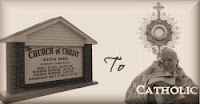photo by marylea
 Once again, this is a Jewish concept brought into Christianity. In Exodus, we first read of Moses asking God to dwell among them (34:9). This is indeed a dangerous thing, and God warns against it at first (33:3) but graciously agrees at Moses' request and acknowledgement of their unworthiness. And so, a tent is set apart as a sacred space to be God's dwelling place. A whole chapter (35) is taken to describe the very detailed requirements for this space. The numbers used and materials used all have great meaning, they all point to wholeness, to purity, and the best stones, linens, metals, and woods are called for. Obviously, this is no light matter, and nothing is too precious for the dwelling place of God! No expense is spared for this most holy of places, and the Tent is brought with the Israelites through the desert.
Once again, this is a Jewish concept brought into Christianity. In Exodus, we first read of Moses asking God to dwell among them (34:9). This is indeed a dangerous thing, and God warns against it at first (33:3) but graciously agrees at Moses' request and acknowledgement of their unworthiness. And so, a tent is set apart as a sacred space to be God's dwelling place. A whole chapter (35) is taken to describe the very detailed requirements for this space. The numbers used and materials used all have great meaning, they all point to wholeness, to purity, and the best stones, linens, metals, and woods are called for. Obviously, this is no light matter, and nothing is too precious for the dwelling place of God! No expense is spared for this most holy of places, and the Tent is brought with the Israelites through the desert.Later in the Old Testament, the Temple replaces the tent as there is no need for it to be portable any longer. Once again, great care is taken and no expense spared for the building of this Temple. Directions are given in 1 Chorinthians 28, and in the following chapter we can see His dwelling place was to be beautiful, crafted by the best artisans, and created with the wealth given willingly by King David and his people.
But now, because of the delight I take in the house of my God, in addition to all that I stored up for the holy house, I give to the house of my God my personal fortune in gold and silver: three thousand talents of Ophir gold, and seven thousand talents of refined silver, for overlaying the walls of the rooms, for the various utensils to be made of gold and silver, and for every work that is to be done by artisans.(1 Chorinthians 29:3-5)
Sometimes, non-Catholics have a hard time understanding why we often include such ornate and beautiful objects in our churches. The simple answer is because, as Moses and Kind David knew, nothing is too precious for God. If Jesus were coming to one's house to have dinner, I imagine we'd all bring out our best china and crystal, our richest foods...nothing would be too good for God Himself!
And so, the Christian equivalent of the Tent and the Temple, the dwelling place of God, is the Tabernacle. It is often a beautiful and ornate golden box. Outside of every tabernacle is a lamp, called an altar lamp or sanctuary lamp. This lamp is kept lit at all times when the Eucharist is inside to remind us of Christ's presence there. (Also a concept carried over from the Jews, as in Exodus 27:20-21.)
 Out of respect, any time one crosses in front of the tabernacle it is customary to bow or genuflect to acknowledge Christ's presence. People are welcome to come and pray, knowing Christ is there. His presence makes it a holy place, and our actions reflect that. The scriptures remind us, too, that our bodies are also to be considered temples of the Holy Spirit. (1 Cor 6:19) We can look to the beautiful tabernacles to remind us of the amazing gift residing within it, so that when we receive it ourselves we recognize our unworthiness and praise God accordingly.
Out of respect, any time one crosses in front of the tabernacle it is customary to bow or genuflect to acknowledge Christ's presence. People are welcome to come and pray, knowing Christ is there. His presence makes it a holy place, and our actions reflect that. The scriptures remind us, too, that our bodies are also to be considered temples of the Holy Spirit. (1 Cor 6:19) We can look to the beautiful tabernacles to remind us of the amazing gift residing within it, so that when we receive it ourselves we recognize our unworthiness and praise God accordingly.A recent, somewhat controversial issue concerning the tabernacle has to do with its placement in the church. It has become more common to place it off to a side rather than being centrally located, and sometimes even off in a separate room not visible in the main part of the church. It may not seem like a huge deal, but it's likely no coincidence that as the tabernacle became less visible, less central in some places, belief in the Real Presence has seemed to diminish alongside it. Ornate tabernacles replaced with simple wooden boxes could make it easier to forget the precious gift that is dwelling within it. We are physical creatures, and physical attributes remind us of spiritual truths.
The video below shows some examples of tabernacles, both some modern simplistic tabernacles placed off to the side, and more ornate tabernacles cenntrally located. At the end of the day of course, what matters is what is inside...God Himself, who humbly comes to us in the form of bread and wine. May we never forget what a precious gift this is!
How lovely is your dwelling place, O Lord Almighty.
I long, yes, I faint with longing to enter the courts of the Lord. With my whole being, body and soul, I will shout joyfully to the living God.
Even the sparrow finds a home there, and the swallow builds her nest and raises her young at a place near your altar, O Lord Almighty, my King and my God!
How happy are those who can live in your house, always singing your praises.(Ps 84:1-4)
And the Word became flesh and made his dwelling among us, and we saw his glory, the glory as of the Father's only Son, full of grace and truth. (John 1:14)
After this I will return and will rebuild the tabernacle of David, which has fallen down; I will rebuild it’s ruins, and I will set it up so that the rest of mankind may seek the Lord, even all the Gentiles who are called by My name, says the Lord who does all these things. (Acts 15:16-17)



No comments:
Post a Comment